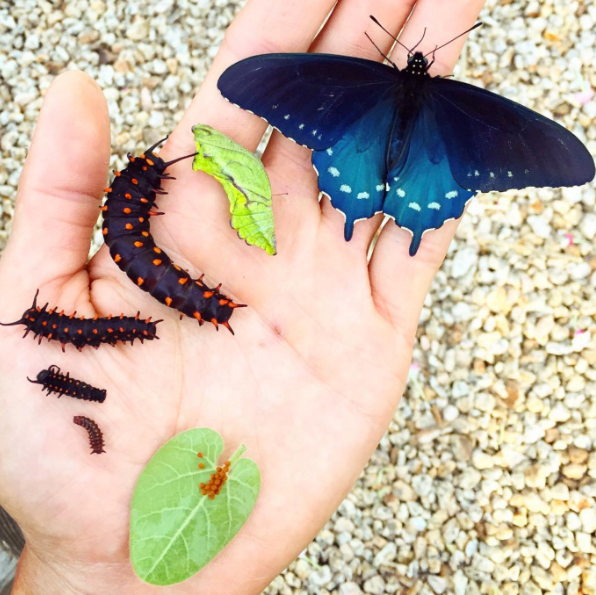The Man Who Saved a Butterfly
If you’re a fan of the book “The Very Hungry Caterpillar,” you’re probably already roughly aware of what the picture above (via Vox) shows. But if not, it’s the life cycle of a butterfly. They start as eggs, as seen on the leaf at the bottom of the picture, and then, going clockwise, mature into various stages of being a gross-looking caterpillar, then form a chrysalis — more on that in today’s From the Archives link — and ultimately, emerges as a glorious butterfly.
A few decades ago, if you were living in San Francisco, you’d find the butterfly pictured above — called the California pipeline swallowtail — throughout the normal course of your day. But as the 20th century came to a close, this particular swallowtail began to disappear from the city and the SF Bay Area more generally. Today, it’s back — mostly due to the efforts of a man named Tim Wong.
Wong, an aquatic biologist at the California Academy of Scientists by day, is a fan of butterfly science as well; as he told Vox in 2016, “I first was inspired to raise butterflies when I was in elementary school. We raised painted lady butterflies in the classroom, and I was amazed at the complete metamorphosis from caterpillar to adult.” As an adult, he learned about the California pipeline swallowtail and its disappearance from his home city. The butterfly gets its name from the California pipeline plant, a vine that’s endemic to northern California. When the butterfly is in its larval stage — that is, when they’re caterpillars — the only thing they’ll eat are these vines. Once they grow to be butterflies, this isn’t an issue, as the butterflies will eat from all sorts of plants. But if you don’t have California pipeline vines, you don’t have California pipeline caterpillars, and, in turn, you don’t have their butterflies, either. And as San Francisco grew and urbanized, the vines became increasingly rare. The butterfly, as a result, all but disappeared from the city.
Wong decided to solve the problem. As GoodGoodGood explains, he “was able to find the plant in the San Francisco Botanical Garden in Golden Gate Park and was allowed to take home a few clippings of the plant.” Then, he built a habitat for the caterpillars — a screened enclosure with pipeline vines and some other plants that grow near the pipelines in nature. After the plants grew to a sufficient number — dozens, if not hundreds of vines — he went into the more rural places outside of the city to find some caterpillars to populate his new backyard bug jungle. He came home with twenty, more than enough to get started.
Over the years since, Wong has helped raise thousands of new caterpillars and butterflies. When the butterflies emerge from their chrysalises, he brings them to the Botanical Garden, which is now home to a healthy population of California pipeline swallowtails, thanks in large part to Wong’s efforts. And if anything were to go wrong, no worries — as of 2023, per Yahoo! Life, Wong still runs his backyard butterfly habitat.
Bonus fact: Butterflies are herbivores — they eat plants, not animals. But some of them are fans of turtles, giving them what looks like kisses, as seen here. What’s going on there? The butterflies are probably looking for sodium. These butterflies and turtles are in Peru, and as the BBC explains, “the Andes cut off weather and mineral deposits from rain that would come in from the Pacific Ocean,” so most of the rain in the area comes from the Atlantic Ocean. And by the time the rain arrives, it’s depleted of most of the nutrients you typically find in rainwater. Butterflies and some other creatures (bees, per one BBC video, which shows the butterflies descending on a turtle) sometimes flock to turtles. The insects are, effectively, drinking the turtle’s tears, thereby acquiring the sodium the butterflies need to survive.
From the Archives: Liquid Memories: The caterpillar turns into goo in the chrysalis, goes through a massive change, and emerges as a butterfly. But what happens to its pre-chrysalis memories? They may stay intact.

